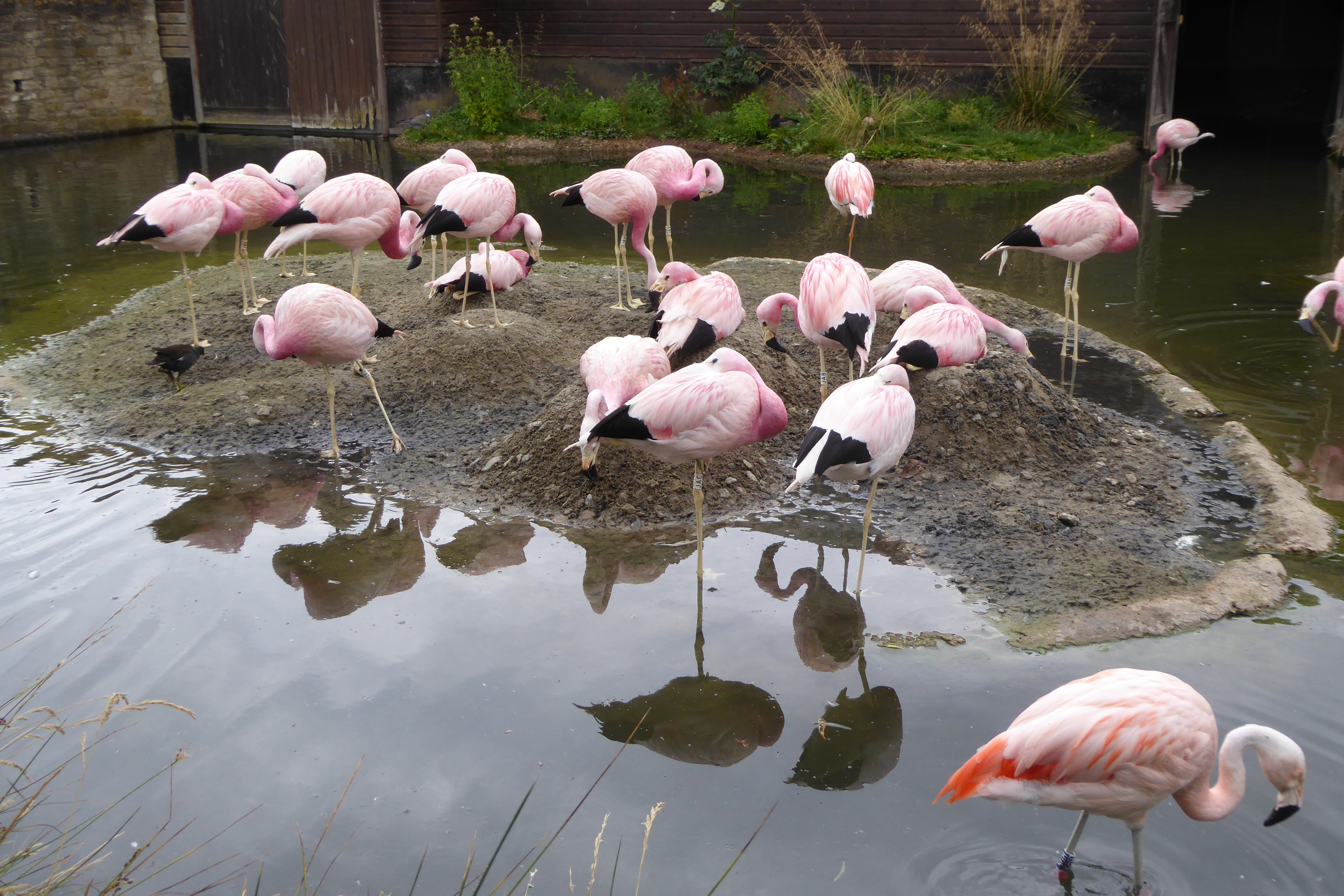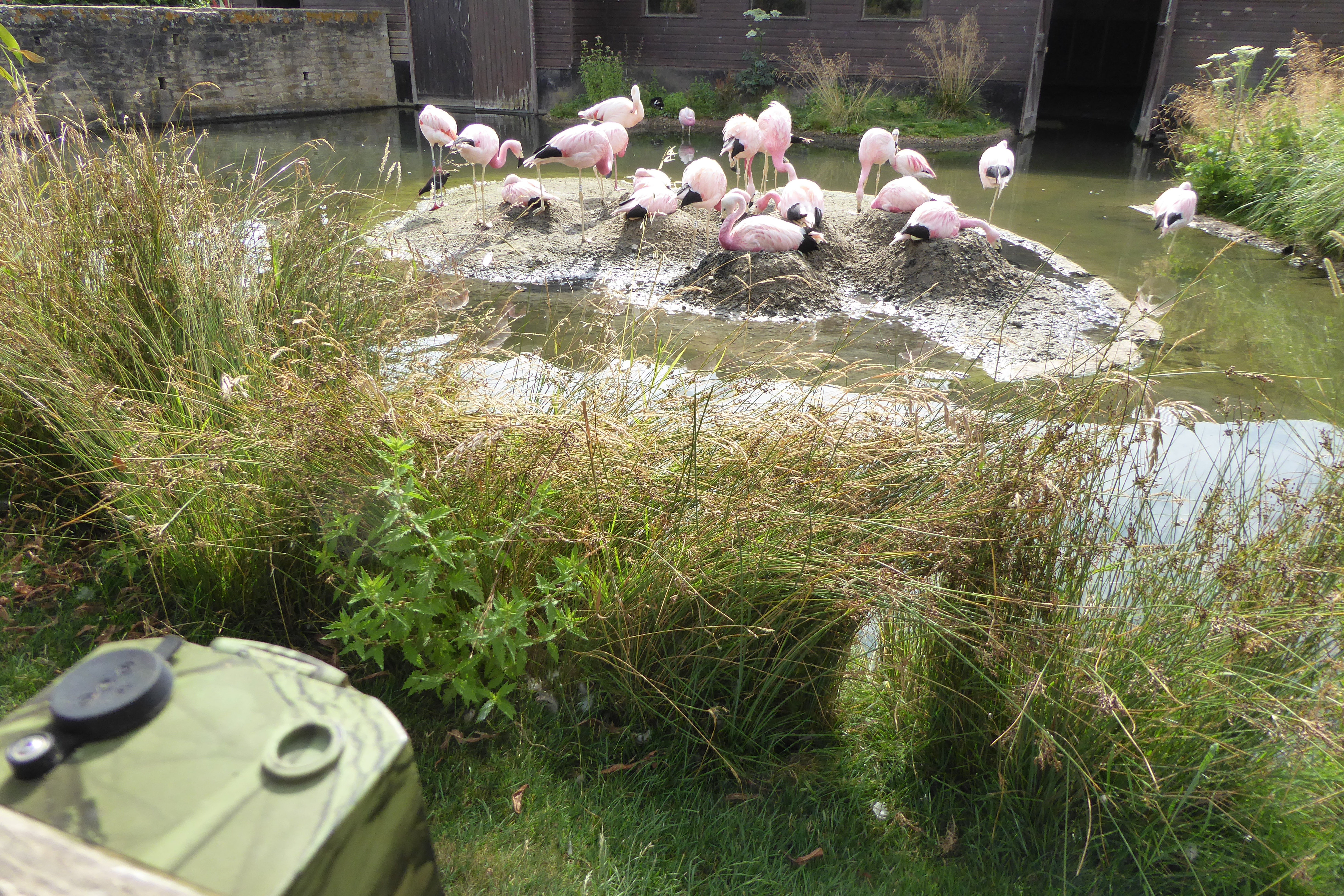An Andean update
The Andean flamingos are potentially this year's summer sensation at WWT Slimbridge. At least they are for me and the other flamingo lovers on site! Here's an update with some footage and photos of what they have been getting up to. And why you should come and see them.
As of this weekend (21st/22nd July) eight eggs have been laid. There are six large nest mounds (on the right and centre of the photo above) and two or three less "structurally sound" nests that are on the left of the island. Potentially, there are seven pairs of birds sitting. It's hard to tell just how many pairs are involved as some birds, in these nests to the left of the main sitting group, are jostling and swapping position over some less well-built nests.
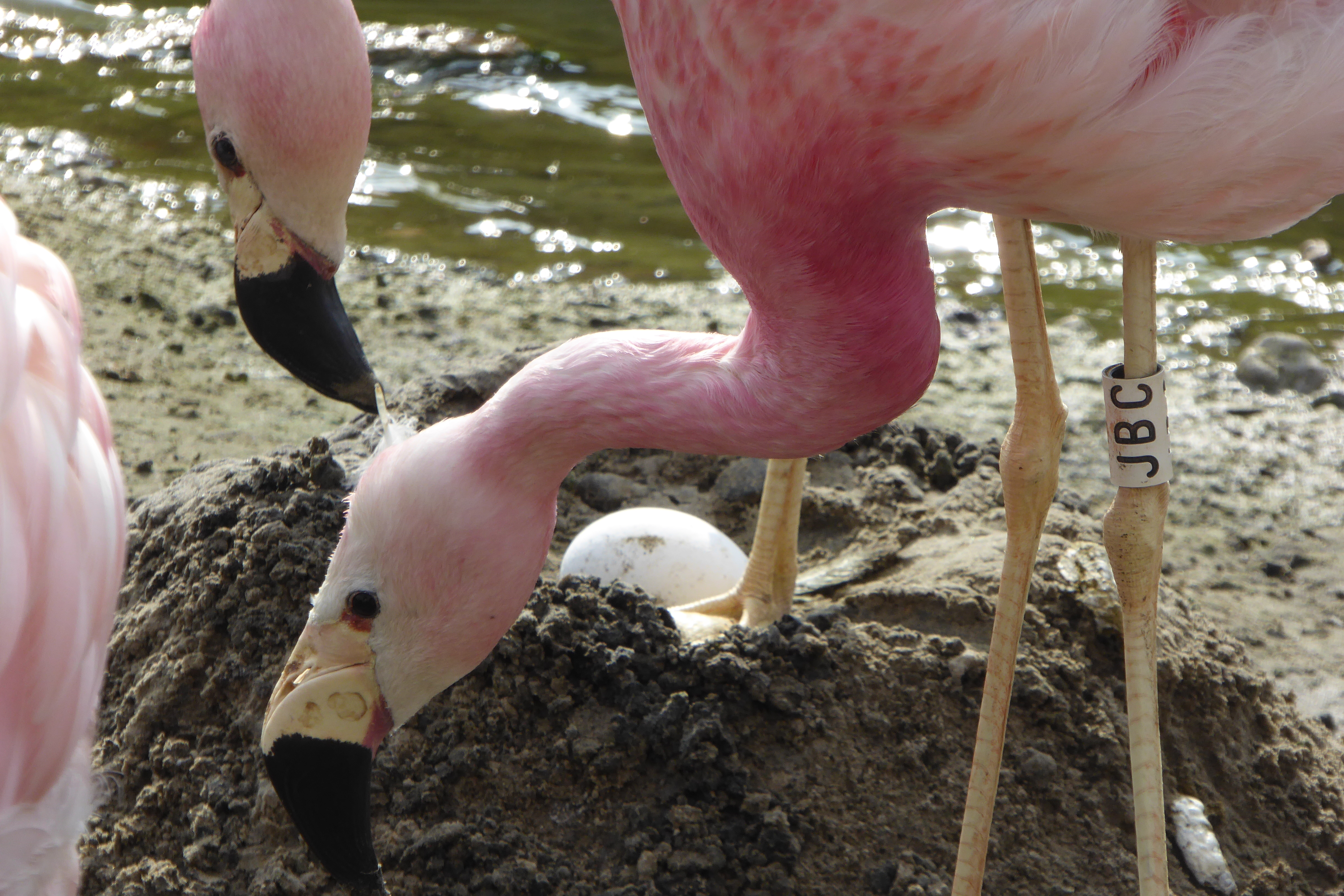 Egg number eight. Freshly laid on the morning of 21st July. Yes, that is an actual Andean flamingo egg in this photo- not a dummy.
Egg number eight. Freshly laid on the morning of 21st July. Yes, that is an actual Andean flamingo egg in this photo- not a dummy.
Sparky and Phil are checking on the nests regularly- making sure the sand is nice and damp so that the birds can keep building, and they are keeping a watch on the arrival of any new eggs. These get whisked quickly away to the safety of the Duckery and a warm, secure incubator.
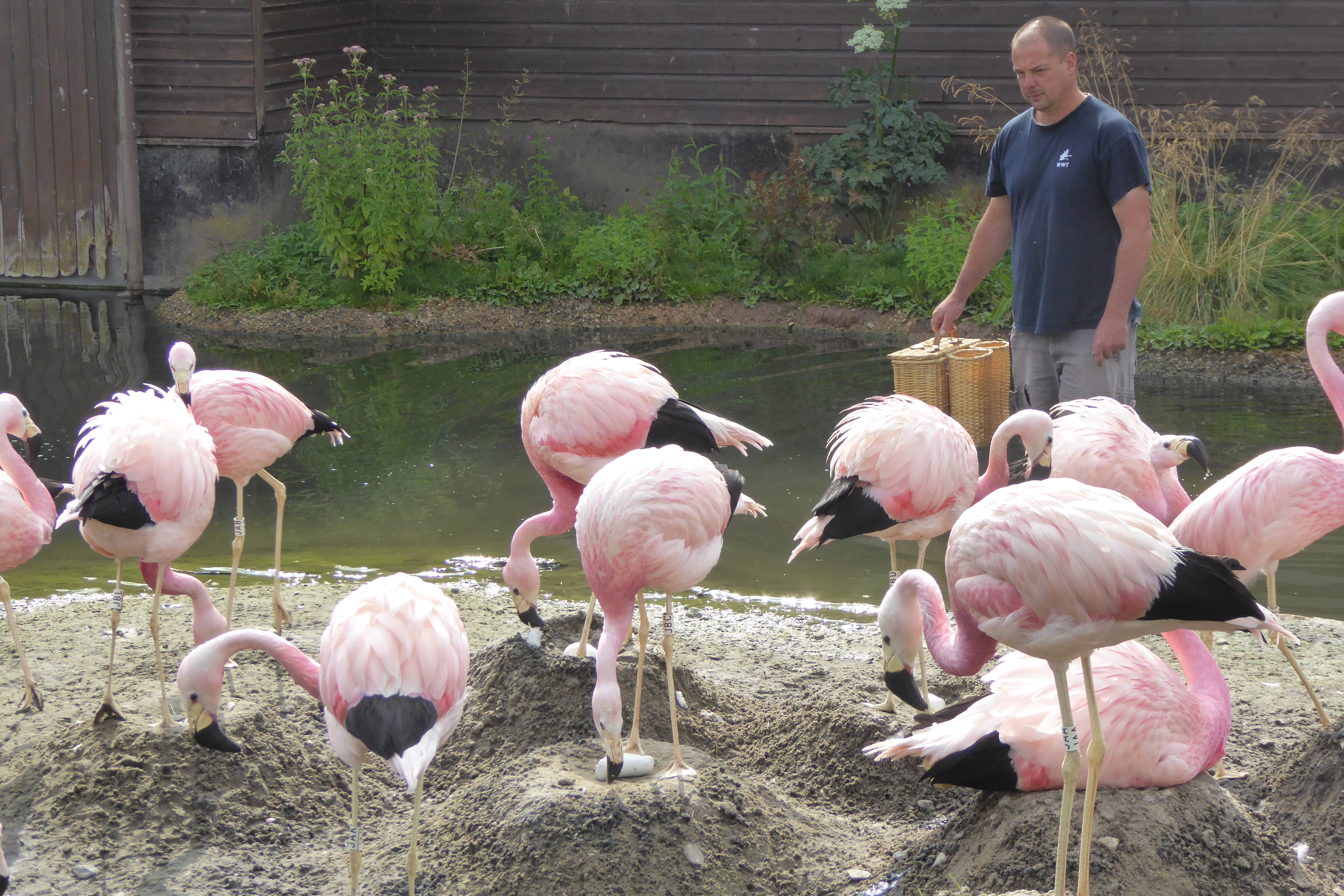 Sparky carries a basket full of eider down over the Andean flamingo colony to collect the newest egg laid. A dummy is popped in its place and the bird instinctively goes back to sit on it.[/caption]
Sparky carries a basket full of eider down over the Andean flamingo colony to collect the newest egg laid. A dummy is popped in its place and the bird instinctively goes back to sit on it.[/caption]
You can see the real egg at the back of the photo above. The bird is stood up, and guarding her nest; she is directly behind "JBC"- an old female who is incubating a dummy egg (that replaced an egg laid earlier in the week). To the back right of "JBC" is a pair- "JBU" (who laid the first egg) and JBT, a male who had a long-time partner ("JAD") that sadly died in 2014. It's nice to see that he has since found another companion.
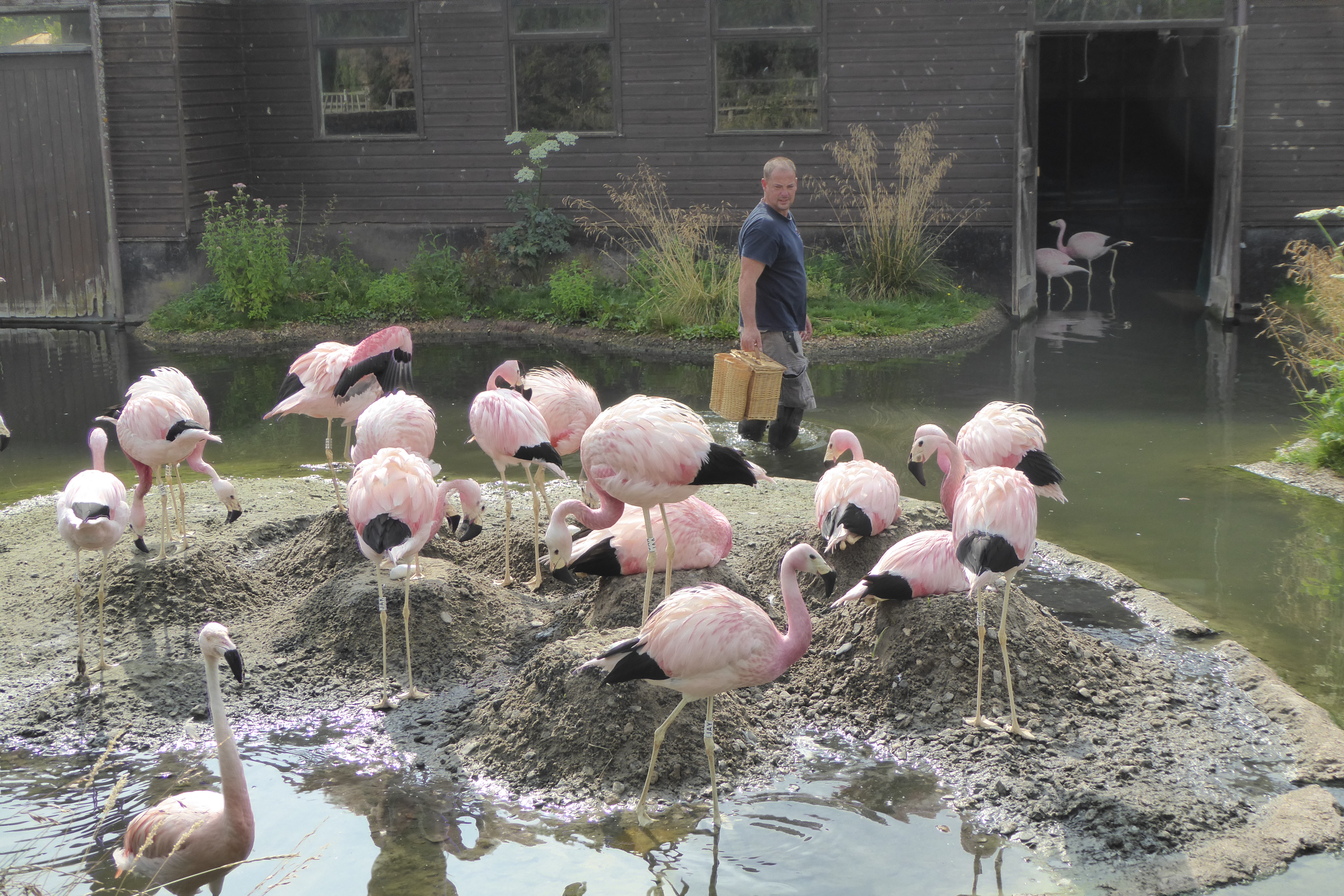 The flock has hardly flinched whilst the egg was swapped for a dummy. This shows how tight the birds are sat on their nests, and how calmly the Slimbridge aviculturists can work around their flamingos.
The flock has hardly flinched whilst the egg was swapped for a dummy. This shows how tight the birds are sat on their nests, and how calmly the Slimbridge aviculturists can work around their flamingos.
A few interesting birds to see in the photo above. "JAE" is the female returning to the nest of the eighth egg laid- she is a bird who arrived at WWT Slimbridge in 1966. The tall male flamingo, centre right, with his head down and pointing left is "JAA"- the chick hatched in 1988. It's good to see him (as a relative youngster) part of this nesting attempt.
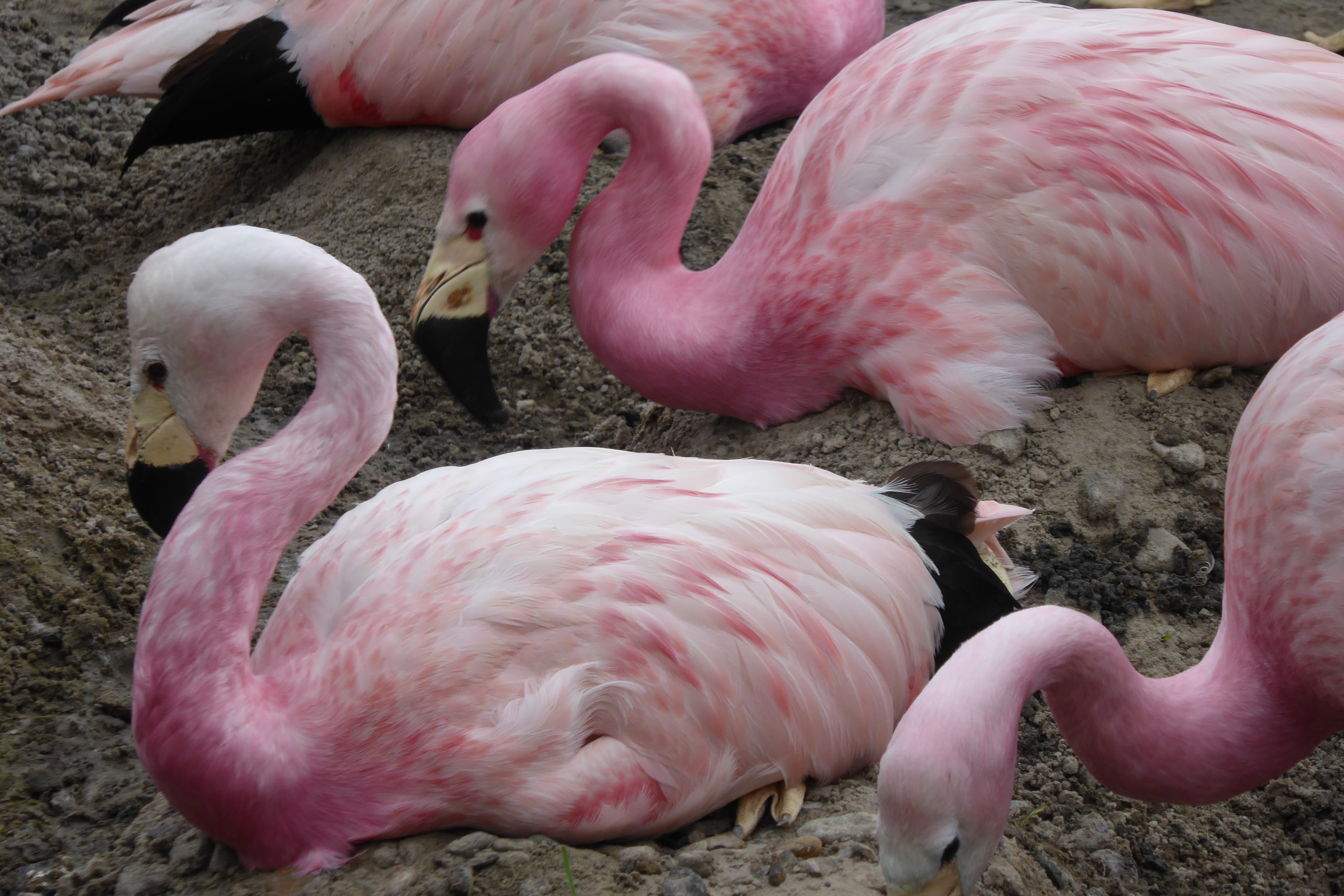 Three Andean flamingos building up their nests as they incubate. The large, colourful male at the back of the photo is JAU- one of the ones to help kick things off at the start of the month.
Three Andean flamingos building up their nests as they incubate. The large, colourful male at the back of the photo is JAU- one of the ones to help kick things off at the start of the month.
The colour difference in the heads and necks of the flamingos in the photo above is interesting. The birds are getting faded by the sun (and quicker than normal as they are sat in more direct sunshine than usual). But it also shows the more intense colour of a dominant bird ("JAU") compared to those that maybe less influential in the flock.
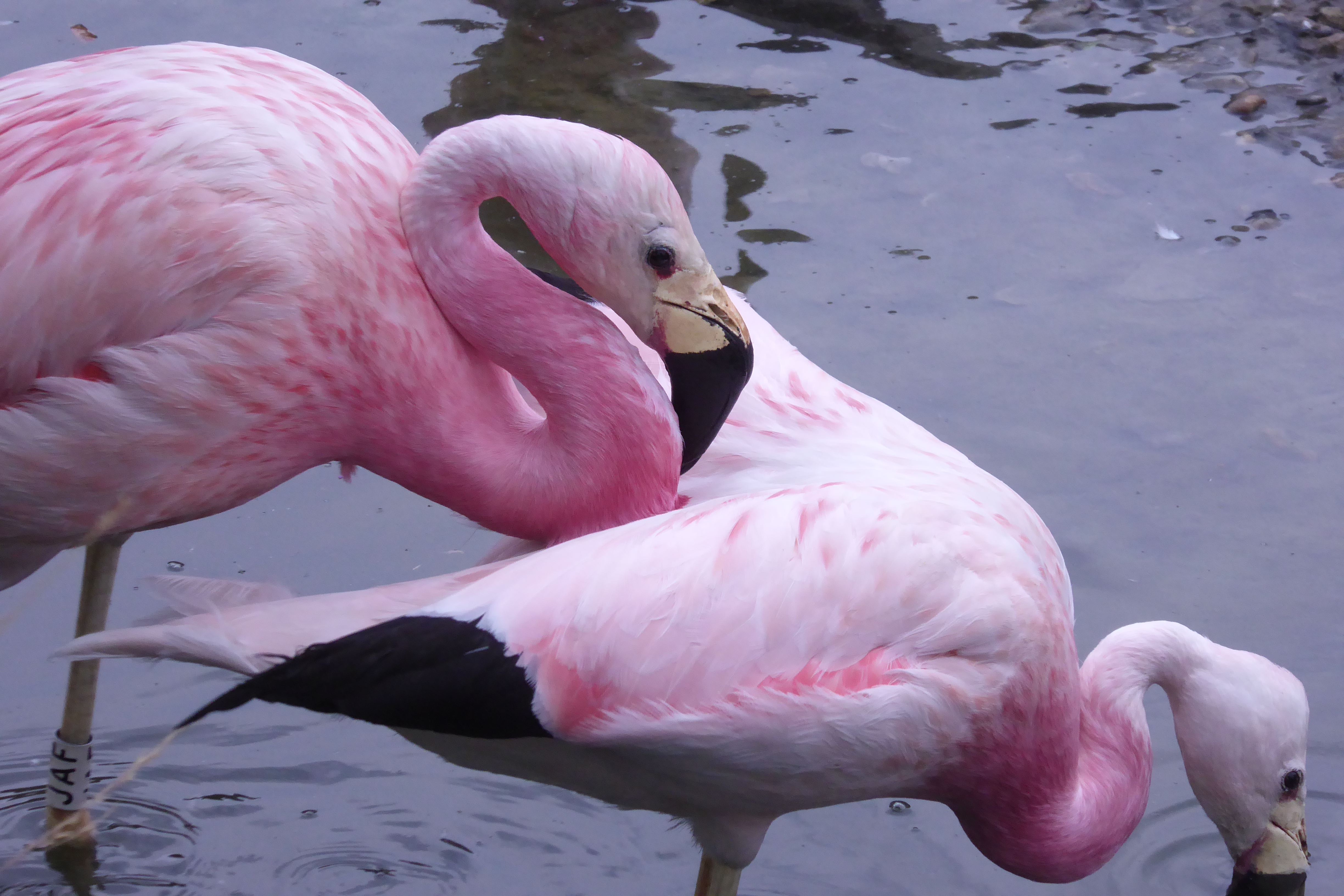 Mating behaviour. The female makes a platform out of her wings, for the male to hop on to for copulation. Mating generally happens in the water and you will see the female leading the male on a merry dance, before she will agree to take up this pose and let him mate. This is her way of checking he is a fit and strong bird, and the best one to fertile her egg.[/caption]
Mating behaviour. The female makes a platform out of her wings, for the male to hop on to for copulation. Mating generally happens in the water and you will see the female leading the male on a merry dance, before she will agree to take up this pose and let him mate. This is her way of checking he is a fit and strong bird, and the best one to fertile her egg.[/caption]
This is "JAF" mating "JBD". "JBD" is another character. She's doesn't really fit into a well-established pair or trio. She arrived at Slimbridge in 1961 and was often found with WWT's oldest Andean flamingo ("JBB") who died in 2016, but is often seen moving between different threes or fours within the flock. "JAF" is a very quarrelsome bird (he especially does not get on with "JAK") and again, has no defined connections to other birds in this group.
So what are the birds doing on their nests? The clip below shows an incubation duty change over:
https://www.youtube.com/watch?v=vHGEsfxCwb0
And we have installed a remote camera to capture footage of the flamingos on their nests 24/7. You can see the view of the camera in the photo below. It's too good an opportunity to miss collecting data on the breeding biology of these birds, and as we've waited 15 years since it last occurred, the excited scientist in me needs to measure what they are up to!
I have downloaded some content from the camera already, but will post more on this in another blog entry. But to give you an idea, the video below is four short pieces of film stitched together to show the birds' activity from afternoon into the late evening.
https://www.youtube.com/watch?v=nRrGHkN7T70
To not leave him out... what about Mr James? Well he's been poking around on the edge of the colony but he can get on the wrong end of the breeding birds' tempers. I think this is a bit of new experience for him- so often used to throwing his weight around and getting his own way with the normally placid Andeans. Their change in behaviour during nesting appears to have caught Mr James by surprise.
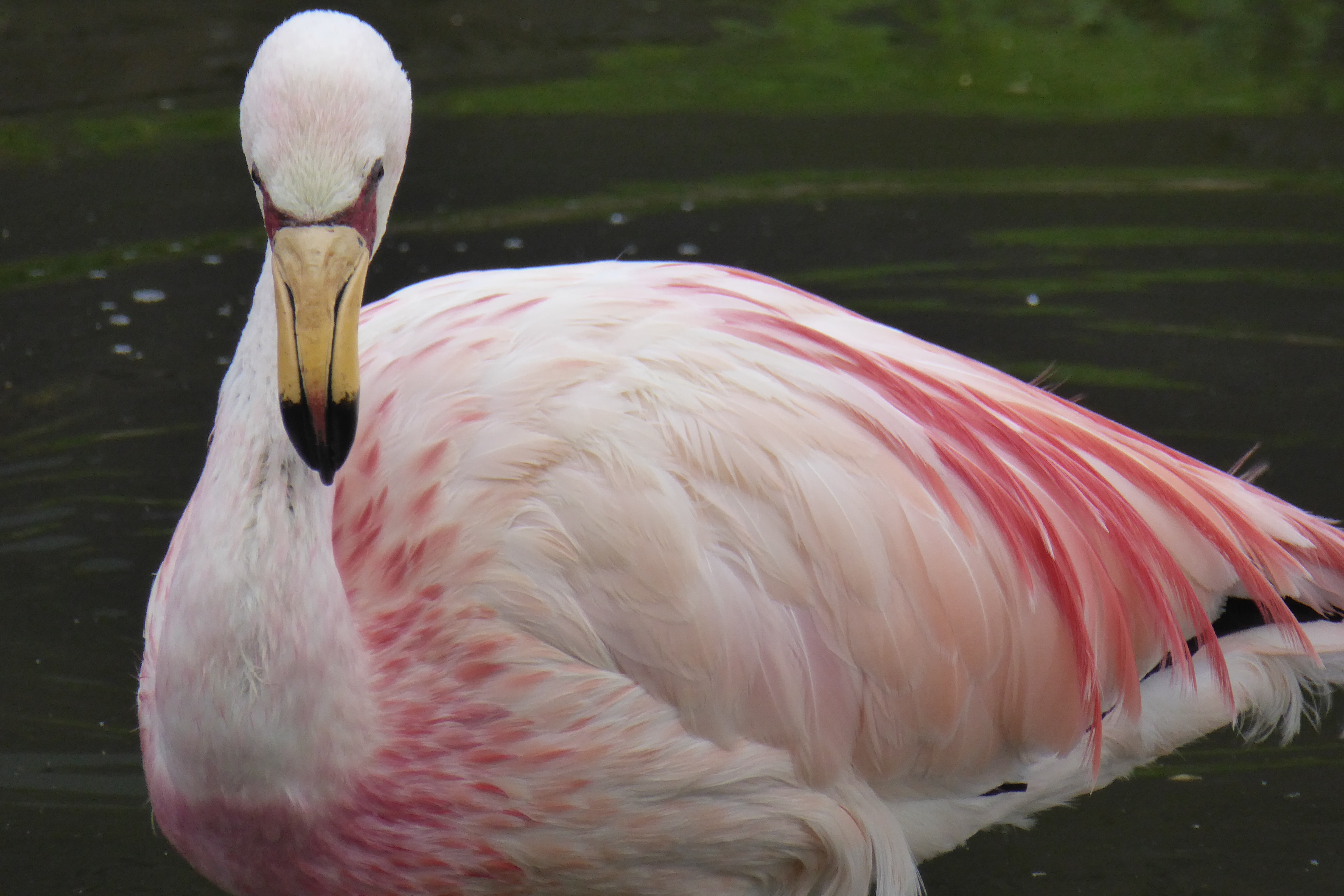 Still pretty in pink. But not as bossy as normal. Mr James is a bit unsure of the happenings around him...
Still pretty in pink. But not as bossy as normal. Mr James is a bit unsure of the happenings around him...
Here's a clip (below) of him trying to walk across the nest island as normal, but having to detour away from jabbing beaks.
https://www.youtube.com/watch?v=Ktr7liRNIMM
The link below is a longer clip of the birds' nesting behaviour. It's great to see this privileged view inside the colony. Even if nothing is produced, the chance to watch this event take place is still very special.
https://www.youtube.com/watch?v=aLhRk8gF_wo
And finally, I have taken this snippet (below) from the longer clip to show you a really nice behaviour that could be missed. After an incubation change, the new bird that is about to sit on the egg, climbs onto the nest mound and shakes its feet vigorously. This removes dirt, mud and germs, and reduces the chances of potential infections finding their way into the developing egg. Cool to see right?!
https://www.youtube.com/watch?v=NFbN864j9RY
I hope you have enjoyed this extra post, delving into the life of the Andean colony. Here's hoping there will be more news and updates to come and the summer progresses!
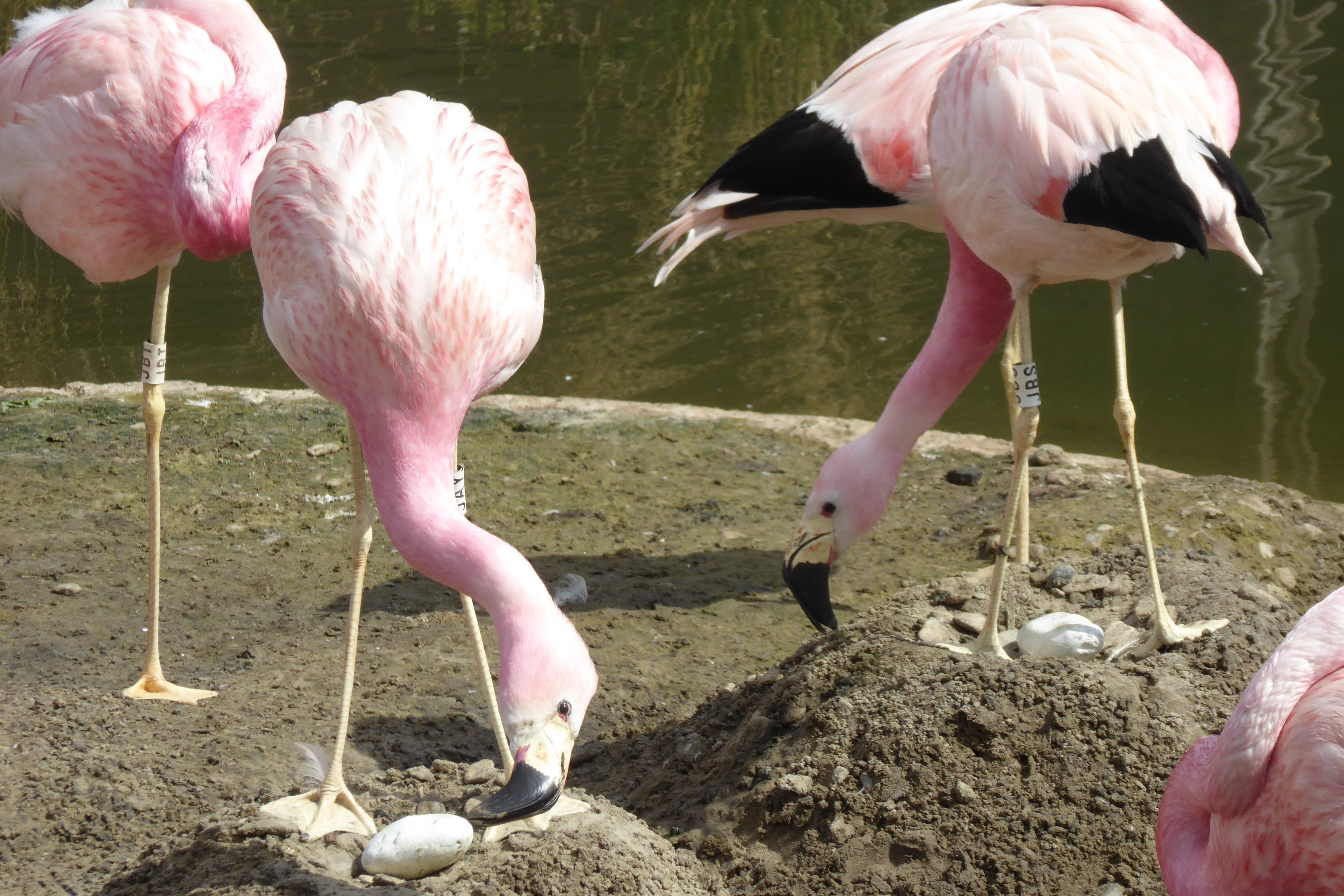 "This is a very pebble-shaped egg. Or a rather egg-shaped pebble. Ah well, I haven't seen one in over decade so I am sure it'll be comfy to sit on..."
"This is a very pebble-shaped egg. Or a rather egg-shaped pebble. Ah well, I haven't seen one in over decade so I am sure it'll be comfy to sit on..."
